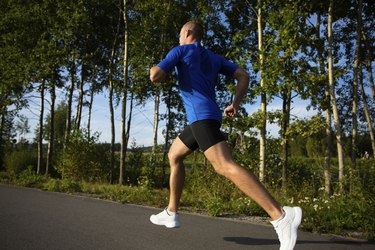
When you're a runner, your legs are itching to hit the road, find their stride and eat up the miles. But if you're an injured runner, recovering from a condition such as shin splints, it's important to take a rest from running and ease back into your running program after your shin splints have healed. Shin splints occur when the tendons, muscles, bone tissue and other tissues surrounding the tibia become inflamed from overuse or hard exercise. They need time to heal, and then you can slowly return to running.
Step 1
Get your doctor's approval to run again. If you start running too early before your shin splints have properly healed, you'll further damage your shins and cause more inflammation – not to mention pain. Before you start running, make sure all of your pain is resolved, and get a checkup from your doctor and the okay to resume your running program to avoid more injuries.
Video of the Day
Step 2
Check your shoes. Shin splints can occur from running in shoes that don't offer enough support or cushion, and the American Academy of Orthopaedic Surgeons, or AAOS, notes that shin splints are more common in people with flat feet or extremely rigid arches. If your shoes aren't cutting it, invest in a pair that fits well and offers good support and plenty of cushion to absorb the impact during your run.
Step 3
Create a plan to gradually increase your speed and distance. Even if you were in great shape before you developed shin splints, your legs need to take it slowly as you resume your running regimen. Start out by just walking for a few days. Create a plan that starts out slowly and running short distances. See how your legs handle it. Over time, slowly run faster and add more distance to your regular runs as your leg muscles strengthen to avoid a recurrence of shin splints.
Step 4
Stretch, ice and treat your legs well. Remember to take extra time to warm up and stretch your muscles, notes the AAOS. Look for signs of pain, and stop exercising as soon as you notice any discomfort. If you want to keep inflammation and shin splints at bay, try applying ice after a run. You may also want to take a nonsteroidal anti-inflammatory drug, or NSAID, to manage any pain and inflammation.
Video of the Day